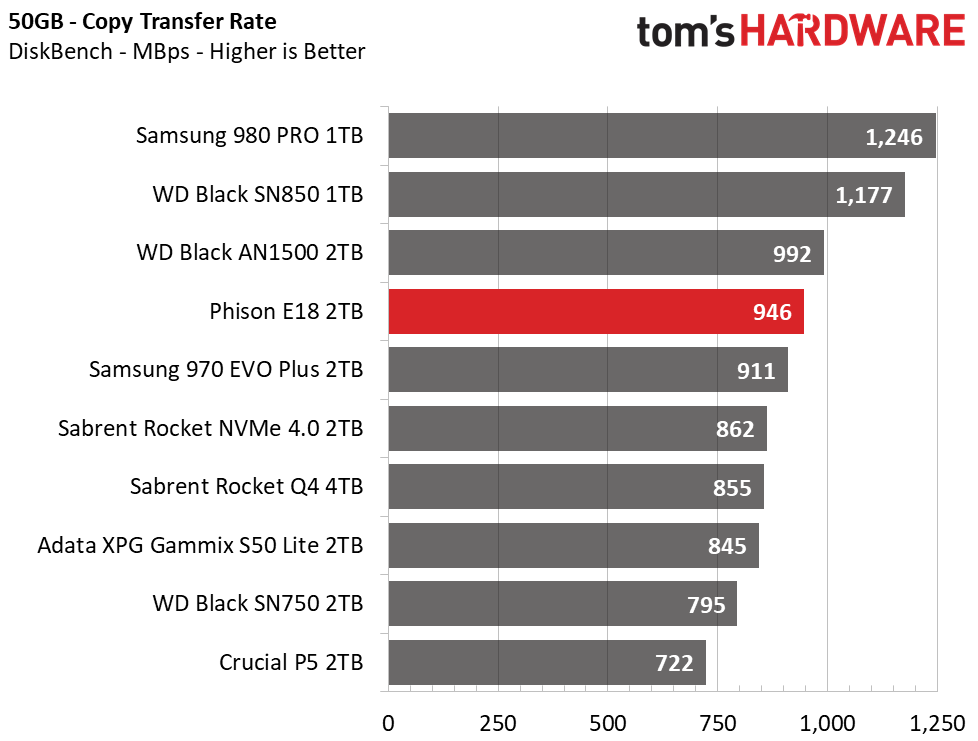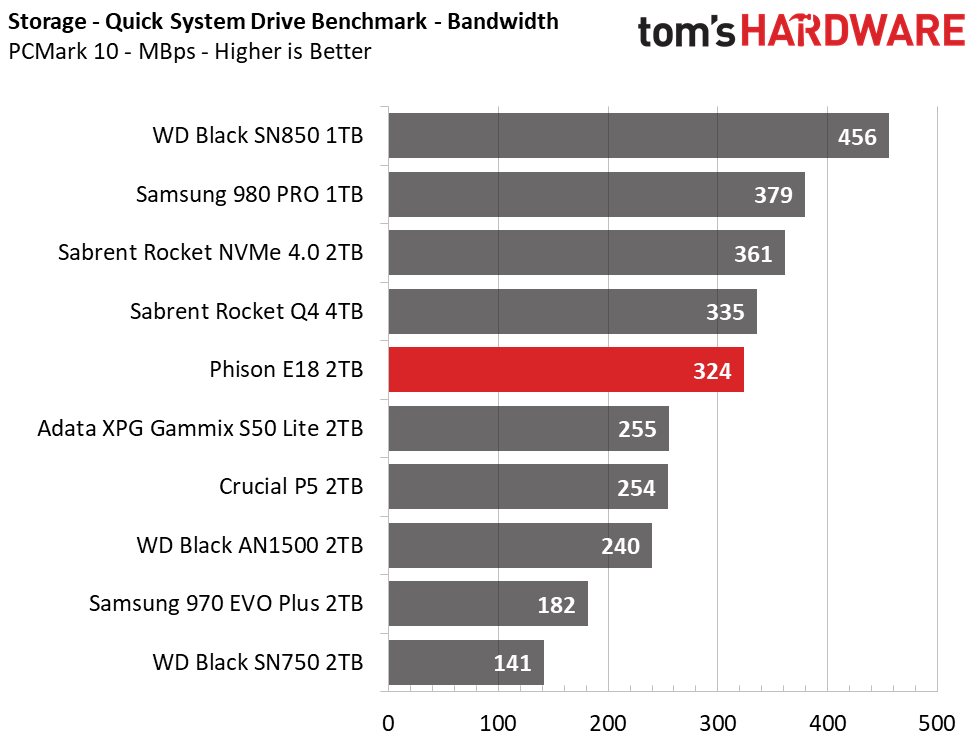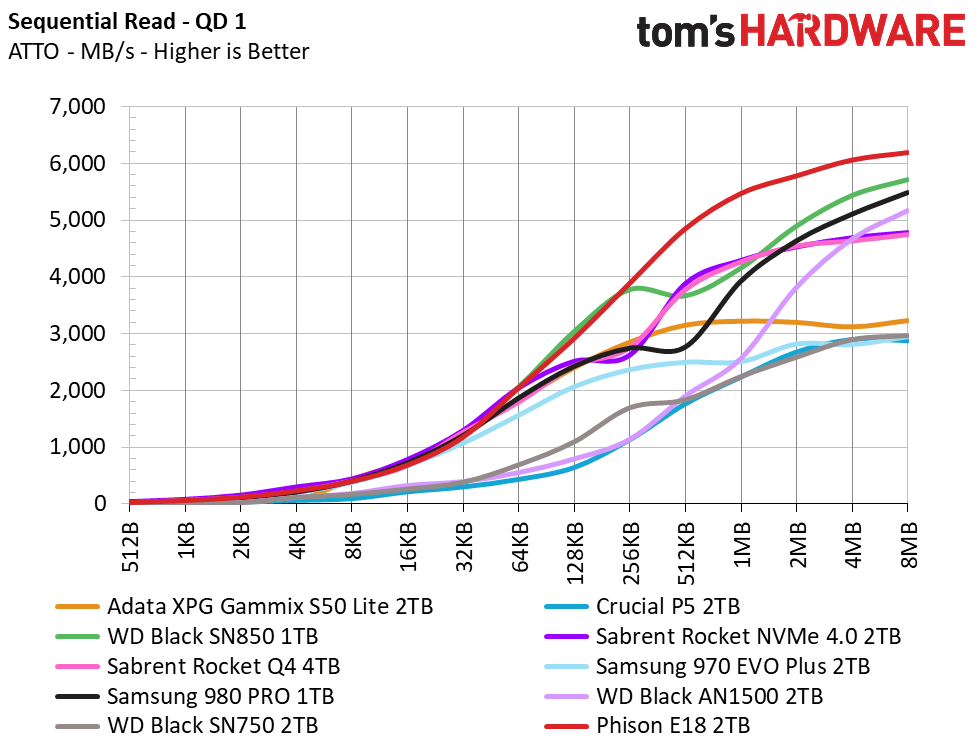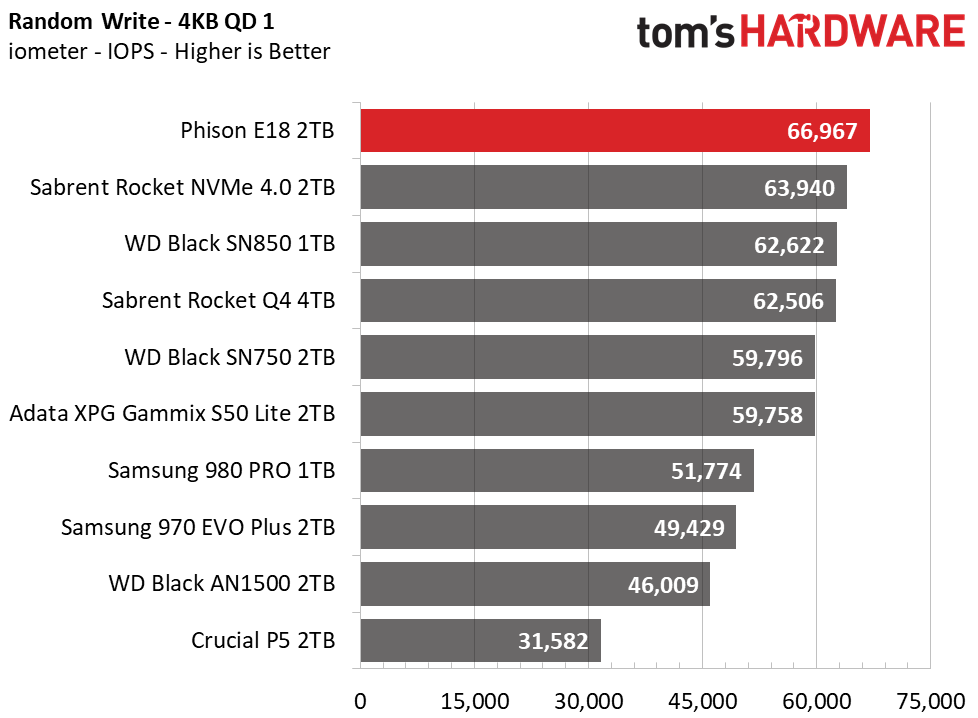Phison's New PCIe 4.0 Controller Tested: 7.4 GBps of Potential
Phison’s PS5018-E18 could be the fastest SSD controller yet.
Just as the CPU is the brains of your computer, the SSD is the brains behind your storage drive. Though many companies produce SSDs, most don't make their own controllers. Phison is a leader in the SSD controller space and one of only a few companies that produce the hardware that manages your precious data on the latest flash.
Phison has spearheaded the PCIe Gen4 NVMe SSD market with its PS5016-E16 NVMe SSD controller and has enjoyed staying on top for quite a while. Samsung’s 980 PRO recently dethroned Phison the top-ranking title, but Phison's next-gen PS5018-E18 NVMe SSD controller may lead their way to victory once again, assuming the final firmware quirks get worked out.
The Prototype with a Speed Governor
Phison was gracious enough to send over an early engineering sample of the PS5018-E18 to play with. However, as exciting as early sampling is, ES units aren’t without drawbacks. The unfortunate part here is that the device is roughly 1-2 firmware revisions away from production and paired with slower than optimal flash. The company officially rates the PS5018-E18 to deliver throughput of up to 7.4 / 7.0 GBps read/write as well as sustain upwards of 1 million random read and write IOPS with next-gen flash.

Our prototype comes with 2TB of Micron’s 512Gb B27B 96L TLC flash operating at 1,200 MTps rather than Micron’s recently announced 176L replacement gate TLC flash, capable of saturating the controller's max interface speed. While this prototype won’t be nearly as fast as the final production units, it is interesting to see how it compares in testing at this point with the current generation flash. A recent news post shows that it is even capable of sustaining a hefty 1.2 million random write IOPS in the configuration we have in our hands today.
Architecture of PS5018-E18 SSD Controller

Built from the ground up and produced one TSMC’s 12nm technology node, Phison’s PS5018-E18 is quite the capable PCIe 4.0 x4 SSD controller in terms of features and performance. Phison crammed in five Arm Cortex R5 CPU cores into this thing with three acting as primary cores for the heavy work while the other two are clocked lower for the company’s Dual CoXProcessor 2.0 code to efficiently help offload some of the strain from main core workloads.


The controller interfaces with the NAND over eight NAND flash channels at up to 1,600 MTps and supports capacities of up to 8TB with 32 chip enables. There are eight packages on our sample, four on each side thanks to the small size of the controller that measures just 12 x 12mm. The design leverages a DRAM-based architecture, too, with our sample containing two SK hynix DDR4 chips, one on each side of the PCB.
Features of Phison PS5018-E18 SSD Controller
Phison’s PS5018-E18 meets the NVMe 1.4 spec and comes with a bunch of features. As per usual, it comes with support for both Trim and S.M.A.R.T. data reporting. Like other controllers, it supports Active State Power Management (ASPM), Autonomous Power State Transition (APST), and the L1.2 ultra-low power state. Thermal throttling is implemented, but isn’t of much concern as the new controller doesn’t get too hot in most use cases, and mind you, that is without a nickel integrated heat sink.
Get Tom's Hardware's best news and in-depth reviews, straight to your inbox.
It also leverages the company’s fourth-generation LDPC ECC engine, SmartECC (RAID ECC), and End-to-End Data Path Protection for robust error correction and enhanced data reliability. It even supports hardware-accelerated AES 128/256-bit encryption that is TCG, Opal 2.0, and Pyrite compliant and comes with crypto erase capability.
Phison’s E18 supports a fully-dynamic write caching like the E12S and E16 before. Therefore, the SLC cache size spans 1/3rd of the drive’s available capacity when using TLC flash. The company also implemented SmartFlush, which helps to quickly recover the cache for predictable and consistent performance.
Test Bench and Methodology
- Asus X570 ROG Crosshair VIII Hero (Wi-Fi)
- AMD 3600X @4.3 GHz (all cores)
- 2x8GB Crucial Ballistix RGB DDR4 3600 MHz CL16
- Sapphire Pulse Radeon RX570 4GB
- Corsair RM850x
The initial results you see in this article are with the SSDs tested at 50% full capacity and with the operating system drive using Windows 10 Pro 1909. Also, note that while some of the new PCIe Gen4 SSDs are capable of 1 million IOPS, our lowly 6C/12T Ryzen 5 3600X can only sustain 650-700K IOPS at most. We will soon upgrade our test system’s CPU to a 12C/24T Zen 3 5900X to push next-gen storage to the max.
2TB Performance of Phison PS5018-E18 SSD Controller
We threw in a few of the best SSDs into the mix to gauge the Phison PS5018-E18’s performance. We included two of the top dogs, a WD Black SN850 and Samsung’s 980 PRO as well as Adata’s XPG Gammix S50 Lite, an entry-level Gen4 performer based on SMI’s newest NVMe SM2267 controller and 1,200MTps flash.
We included the Sabrent Rocket NVMe 4.0, which has Phison’s E16 controller and Kioxia’s 96L TLC operating at up to 800MTps, and we added in the Sabrent Rocket Q4, which features Micron’s cheaper 96L QLC flash. Additionally, we threw in Crucial’s P5, Samsung’s 970 EVO Plus, WD’s Black SN750, and AN1500 as some PCIe Gen3 competition.
Game Scene Loading - Final Fantasy XIV
Final Fantasy XIV Stormbringer is a free real-world game benchmark that easily and accurately compares game load times without the inaccuracy of using a stopwatch.

When it comes to game loading, the Phison PS5018-E18 proves more competitive than the E16 before it, but with the current flash, even Samsung’s 970 EVO Plus takes the lead over it in this test. The E18 is not quite as responsive as Samsung’s 980 PRO nor WD’s Black SN850, at least not yet.
Transfer Rates – DiskBench
We use the DiskBench storage benchmarking tool to test file transfer performance with our own custom blocks of data. Our 50GB dataset includes 31,227 files of various types, like pictures, PDFs, and videos. Our 100GB dataset consists of 22,579 files, with 50GB of them being large movies. We copy the data sets to new folders and then follow-up with a read test of a newly-written 6.5GB zip file and 15GB movie file.




When copying around datasets and reading large files, the Phison PS5018-E18 prototype delivered responsive performance, especially strong read performance, but it isn’t quite on par with the 1TB WD Black SN850 and Samsung 980 PRO. When copying our 50GB and 100GB datasets, the Phison PS5018-E18 ranked fourth place, outperforming most of the Gen3 competitors, but trailing WD’s mighty RAID 0 configured Black AN1500.
Trace Testing – PCMark 10 Storage Tests
PCMark 10 is a trace-based benchmark that uses a wide-ranging set of real-world traces from popular applications and everyday tasks to measure the performance of storage devices. The quick benchmark is more relatable to those who use their PCs for leisure or basic office work, while the full benchmark relates more to power users.






While previous tests show minor gains over the E16, PCMark 10 quick results look to have degraded compared to the E16 and are a little on the low side. That's a little strange considering there is now an additional core in its architecture. PCMark 10’s Full System Drive benchmark shows improvement, but the Phison PS5018-E18 is still ranking behind both the new Samsung and WD.
Trace Testing – SPECworkstation 3
Like PCMark 10, SPECworkstation 3 is a trace-based benchmark, but it is designed to push the system harder by measuring workstation performance in professional applications.



When hit with some harder workloads in SPECWorkstation3, Phison’s E18 delivered fast performance but didn’t ellipse its competition in the way that Samsung 980 PRO’s performance did. The company will need to work a bit harder to improve to Samsung-like levels here.
Synthetic Testing - ATTO / iometer
iometer is an advanced and highly configurable storage benchmarking tool while ATTO is a simple and free application that SSD vendors commonly use to assign sequential performance specifications to their products. Both of these tools give us insight into how the device handles different file sizes.










In ATTO, we tested Phison’s PS5018-E18 at a QD of 1, representing most day-to-day file access at various block sizes. Based on ATTO’s results, the E18 shows the fastest peak sequential results, but once we bumped up the QD, both the Samsung and WD inched ahead in reads.
The E18 came back and demonstrated very responsive write performance, however, peaking at 6.6 GBps. When it comes to random performance, ranking fourth in read performance and first in write performance, the E18 is fairly competitive with the current flash, but not as tuned as its competitors.
First Thoughts on the PS5018-E18 Prototype
Phison’s PS5018-E18 NVMe SSD controller is impressive on paper and has some fast specs. With five CPU cores, it is just one shy of Crucial’s P5, but isn’t shackled down by a Gen3 PHY and runs much cooler thanks to TSMC’s 12nm technology node.
With our prototype using Micron’s 96L B27B TLC and operating at 1,200 MTps, the controller shows noticeable improvements over the company’s E16 in some workloads, but there are still some kinks to be worked out. Samsung’s 980 PRO and WD's Black SN850 both have the upper hand for now.

The Phison PS5018-E18’s performance will be a lot more interesting to analyze once we have finalized firmware and NAND configurations. With support for up to 1,600 MTps NAND flash, higher speeds are just around the corner and a lot of the performance gap will shrink.
In fact, while it wasn’t until just days ago that Micron announced supporting NAND, Phison already has new prototypes with Micron’s faster 176L (B47R) flash in hand and development is well underway. Retail products are just around the corner, roughly a month or two away.

Sean is a Contributing Editor at Tom’s Hardware US, covering storage hardware.